Profile of interviewees

Note. Own elaboration.
Accountability and social participation as determinants of municipal control and management: A qualitative study of entitlement funds
(*)Artur Angelo Ramos Lamenha; (**)Juedir Viana Teixeira
(*)Universidade Federal de Alagoas
Rio de Janeiro, Brasil
arturo.lamenha@gmail.com
(**)Universidade Cândido Mendes
Rio de Janeiro, Brasil
juedir@me.com
Reception date: 11/09/2022 – Approval date: 03/13/2023
DOI: https://doi.org/10.36995/j.visiondefuturo.2023.27.02.003.en
ABSTRACT
This study presented the determinants of social control in Brazilian municipalities from the point of view of the social responsibility of the municipal councils and institutions involved, considering transparency, legibility in accountability, level of dissemination, technologies, social media and communicative action. For this, a content analysis was carried out based on information on a specific type of collection of rights, with a smaller number of municipalities, through factor analysis of correspondence, dendrogram and interviews with experts to find the determinants of performance in this type of collection with popular participation. The results of the qualitative research show that the most important factors highlighted in the interviews were: the importance of encouraging fundraising, credibility in accountability, orientation to society, collaboration with the structure of entities, dissemination of social programs, support for control bodies, transparency of actions, coordination between social sectors and a culture of solidarity to help those in need. From the point of view of control and social management, the results were: credibility in accountability and orientation to society and the category of collaboration with the structure of the entities.
KEY WORDS: Social Management; Municipal Councils; Legibility; Accountability; Communicative action.
INTRODUCTION
The collective subjects of organized civil society that carry out the control of social programs and policies are the representatives that make up the public councils and conferences, elected directly or through the corresponding political institutions, and participate in the internal and external processes using physical, legal and informative resources and spaces.
From the point of view of effective participation in the process of capturing and monitoring resources for social programs, social control refers to the capacity of organized society to actively interact with the State in the design, indicate solutions, create plans, monitor implementation, prevent corruption and strengthen the exercise of citizenship, with scope in all three spheres of power.
Problems related to democratic accountability are perceived in institutions and actors that have the conditions to hold society to render, assess and approve the accounts, but do not or are not able to do so, and this makes it impossible to improve the democratic system to safeguard the ability to learn from experience and ensure the orderly transfer of power, survival and progress. It is also perceived that the formation of citizens' opinions and preferences is affected by organized professional communication groups, new communication technologies and social media.
In this sense, it is essential to stimulate and ensure growing citizen participation in multi-channel accountability processes with increasing demands for explanations, justifications and sanctions can be interpreted as a positive democratic phenomenon, because, in this way, they enable the political representation of society and, by influencing the terms of the political order, have a transparent, dynamic and secure process of accountability. It is therefore essential to understand how social media can influence individual and collective participation in the accountability of political and public actors.
The qualitative data were collected from three sources: one secondary, obtained from minutes, regulations and documents of council events, conferences and documents collected from the organization under investigation; and the second one, primary, from observations of talks and conferences, and another through interviews with actors from various professional segments involved in social actions. Once the collected data has been presented and described, they were analyzed according to each of the dimensions that make up the proposed model, which were defined in this study as: Accountability, Management and Control, and Social Participation. In this context, the question that arises in this research is: what are the main themes found in the content analysis of conferences and interviews on accountability, management and social participation in rights fundraising?
To carry out the qualitative analysis of this study, 450 websites of social rights councils or municipalities with this function were observed, focusing on minutes, conferences, deliberations and technical notes, including lectures on the collection and use of resources for rights funds, from a legal or accounting point of view; as well as primers or manuals organized by third sector bodies and organizations on the subject.
The data were organized and typed in a single article, on the notepad, recorded and transferred to the Iramuteq 0.7 software to carry out the lexical analysis of the material obtained on control and social participation in the management of rights funds. From these stages of collection, analysis and classification, graphs were drawn up with the aim of illustrating the relationships between the classes, and the main themes used in the interviews that will be described below.
The corpus of this specific part of the analysis was composed of a part of the documents analyzed in the conferences and papers, in order not to generate a significant number of occurrences. The textual statistics were: number of texts: 142; Number of Occurrences: 15,833, referring to the total number of words; Number of Forms: 2,255; Number of fathoms: 1,902, 6.90% of occurrences and 48.43% of forms, with an average occurrence of 111.50.
The results were initially presented by the zip diagram, as shown in the figure below, in which it is demonstrated that many words are little repeated, i.e. there are a large number of words with few repetitions or low frequency, and that the words are identified as being rare, i.e. unpublished words or words that are found only once in the text.
The paper is divided into four chapters, with the introduction in the first chapter, a brief theoretical discussion of the issues investigated, the presentation and analysis of the data in the second, and final considerations in the last.
DEVELOPMENT
Theoretical Framework
The exercise of citizen participation in the control of the efficiency of the use of resources made available to institutions, individually or collectively, requires access to information on the use of the values released, the criteria or policies involved and, in this sense, it is necessary to understand and discuss transparency, citizen control, networked democratic governance, especially in smaller municipalities, including in relation to the knowledge and encouragement of citizen participation, taking into account that transparency is one of the instruments for accountability (Silva, 2019).
In terms of social accountability in the application of public and private resources, it can be observed that the monitoring of special funds that are intended for social protection, such as the protection of children and adolescents, the protection of the elderly and others with welfare function and that have their own legal rules for their use and accountability, but by involving organized civil society in social projects, without renouncing the monitoring of control bodies, are inserted in the practices of local social control for the effectiveness and continuity of donations to projects authorized by the municipality (CNM, 2012; CNPM, 2020; Cezar et al, 2018).
According to Caldas and Freire (2020), readability from the accounting point of view has to do with the effective communication of important information for its evaluation for analysts and stakeholders of the organizations, but considering in this study the management approach, the aim is to carry out a content analysis of the accountability documents of the municipalities, with a view to finding evidence on events related to social management in the execution of the rights funds.
Considering the legibility of accountability as a factor of comprehensibility of the actors involved in the process of collection, use and dissemination of the organization’s results, including social ones (Jang & Rho, 2016; Hesarzadeh & Bazrafshan, 2018; Caldas & Freire, 2020), the structural factors of the Councils and control body of the municipalities involved (Uygur, 2020; Azevedo, 2017, Ayliffe et al, 2017) and the efficiency in the donation processes for social projects (Yao, 2015; Degasperi & Mainardes, 2017), and the communication and social control processes (Entschew & Suchanek, 2017).
According to some observed studies, it is possible to improve accountability with the help of structural factors, such as: the structure of communication, Internet and municipal social networks (Cunha et al, 2011), the activity in Social Networks. Access and communication of content (Santos & Santos, 2014; Fuchs, 2015; Castells, 2012), as well as by citizen participation through the internet, individually through Councils or through religious and political party entities (Baialardi & Petri, 2015).
Other studies have developed the issue of the determinants of social control of special fund resources from the point of view of social accountability of municipalities and the institutions involved (Walker, 2016; Uygur, 2020; Ayliffe et al, 2017; Bahramirad, 2018) and transparency (Ahmad et al, 2020; Pivac et al, 2017; Abu Bakar & Saleh, 2015; Ortega-Rodriguez et al, 2020), as well as involving underlying and interconnected questions, such as donation processes for social projects (Yao, 2015; Degasperi & Mainardes, 2017), accountability of social entities (Azevedo, 2017; Caldas & Freire, 2020; Moreno-Albarracín et al, 2020), disclosure (Ling et al, 2018; Shahib & Risky, 2017; Nor et al. , 2019; Agustiningsih et al., 2017), social media and communicative action, which are important for understanding the significant differences that occur in the volume transmitted to social institutions.
Based on the analyzed data, the content analysis of conferences and interviews on accountability, management and social participation in rights fundraising is presented below.
Data presentation and analysis
The qualitative data were collected from three sources: one secondary, obtained from minutes, regulations and documents of council events, conferences and documents collected from the organisation under investigation; and another primary, from observations of talks and conferences, and another through interviews with actors from various professional segments involved in social actions. Once the data collected were presented and described, they were analysed according to each of the dimensions that make up the proposed model, which were defined in this study as: Accountability, Management and Control, and Social Participation.
For the qualitative analysis of this study, 450 websites of social rights councils or municipalities with this function were observed, focusing on minutes, conferences, deliberations and technical notes, including lectures on the collection and use of resources for rights funds, from a legal or accounting point of view; as well as primers or manuals organized by third sector bodies and organizations on the subject.
The data were organized and typed, in a single article, on the notepad, recorded and transferred to the Iramuteq 0.7 software to carry out the lexical analysis of the material obtained on control and social participation in the management of rights funds. From these stages of collection, analysis and classification, graphs were drawn up with the aim of illustrating the relationships between the classes, and the main themes used in the interviews that will be described below.
The corpus of this specific part of the analysis was composed of a part of the documents analysed in the conferences and papers, in order not to generate a significant number of occurrences. The textual statistics were: number of texts: 142; Number of Occurrences: 15,833, referring to the total number of words; Number of Forms: 2,255; Number of Occurrences: 1,902, 6.90% of occurrences - 48.43% of forms, with an average occurrence of 111.50.
The results were initially presented by the zipf diagram, as shown in the figure below, in which it is demonstrated that many words are little repeated, i.e. there are a large number of words with few repetitions or low frequency, being identified as 164hart words, i.e. unpublished words or words that are found only once in the text. Thus, the diagram showed a certain regularity, as few words are repeated frequently, while many words are evoked with less repetition.
Following the qualitative analysis of the data from the conferences and papers, interviews were conducted with 18 professionals with expertise on the subject collection, in the period from January to March 2021, all interviews being conducted by virtual meetings via google meet, due to the process of social distancing due to the COVID pandemic, with the responses being transcribed to text by google doc and then formatted for Word and Iramuteq.
According to Thiry-Cherques (2009, p.23) the saturation point of an interview occurs at the moment when interviewees start repeating their answers, not adding new information, as indicated below:
[...] In a particular context, experts tend to agree with each other more than novices and laymen on the subject of their competence. This is a tendency to conformism, a natural adherence to the established and verified. The purposive selection that establishes saturation is considered representative when the interview or observation does not add anything to what is already known about the phenomenon or category under investigation.
The saturation point occurred at the eighteenth interview. The average length of the interviews was 1 hour and 25 minutes, which amounted to a total of 37 hours and 50 minutes of recording and transcription of 125 pages. The shortest interview lasted 50 minutes and 45 seconds and the longest interview lasted 1 hour, 42 minutes and 36 seconds.
In terms of gender of the 18 interviewees, 11 were male and 7 were female. The mean age of the respondents was 47 years, with a standard deviation of 1.54, and the mean time spent in research-related activities was 27 years, with a standard deviation of approximately 8.5 years. Descriptive statistics for these respondent groups are presented in the table below.
The choice of interviewees considered, in addition to the professional characteristics and experience of each one in professions that converge in some way to the dimensions investigated in this study, their interest and dedication to participate in civil society actions, besides to institutional public efforts, in an attempt to contribute to the satisfaction of social demands, despite the limitations of time and resources.
Table 1
Profile of interviewees

Note. Own elaboration.
It should be noted that practically all the talks and conferences analyzed in the previous chapter of this study were promoted or had the effective participation of the Public Prosecutor's Office, and the portfolios or manuals were produced with the support of the judiciary, a fact that was relevant for not having interviews with these authors in this study, in order to avoid conceptual repetitions in the proposed methodology. In this sense, the experience of accountants, social workers, economists and lawyers involved in education and popular participation groups in the social management actions of institutions, mainly in the third sector, was sought.
The corpus of this specific part of the interview analysis was composed only of the answers given by the interviewees, so that the same items asked in the interview script were not repeated, generating a total number of invalid occurrences, taking into account that the questions would be repeated in all 18 interviews. In this sense, the textual statistics were: number of texts: 18; Number of Occurrences: 9,119, referring to the total number of words; Number of Forms: 1,366; Number of 178hart: 693 (7.60% of occurrences and 50.73% of forms), with a mean occurrence of 506.61.
The zipf diagram was also performed, with regularity and few differences from the one presented in the previous chapter, showing that many words are repeated with low frequency, and 178hart words were also identified.
Figure 1
Zipf diagram of the interviews
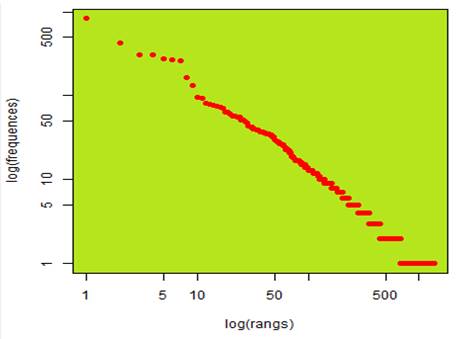
Note. Own elaboration.
After this specific analysis, the word cloud was elaborated with the most cited words corresponding to the largest and most centralized ones. Based on the information obtained by the research, it is verified that the corpus has in the words: Council, How, Resource, Process, Participation, Structure, Institution, Religion and Control, its centrality and, in numerical terms are the most cited, which is explained because, The interviewees observe fundraising, administration and accountability as a process, passing through the public sector and attending to social demand, that is, they are terms expressed, developed and answered in all events with intensity, even to attract the attention of the participants in relation to the theme.
Figure 2
Word cloud: Interviews
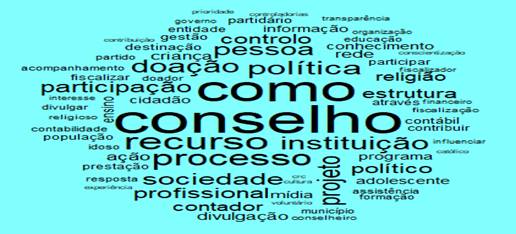
Note. Own elaboration.
After the textual analysis of the interview responses, the analysis of similarity was observed, as it is a graph that represents the connection between the words of the textual corpus, in addition to allowing a better analysis of the central words of each branch with their respective repetitions, highlighting the words: social, with approximation of the terms institution; control; donation and organ; as, with approximation of the terms society, professional and public; and further down the graph the highlight for council was observed, with approximation of the words fund, participation and structure.
Figure 3
Similarity analysis: Interviews
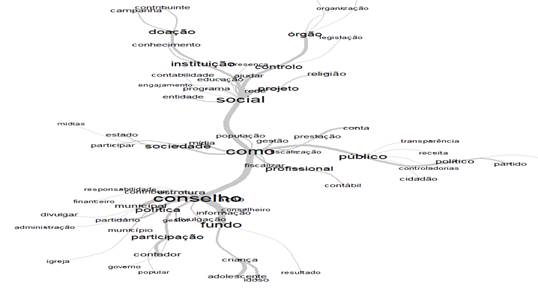
Note. Own elaboration.
Figure 4
Dendrogram Interviews
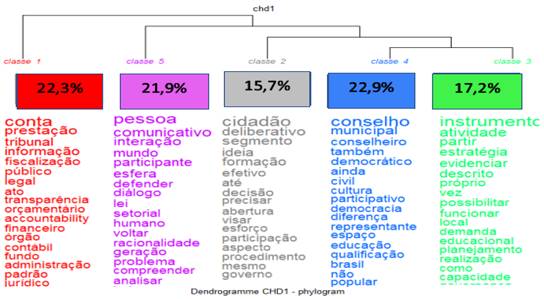
Note. Own elaboration.
The other classes, which account for 77.7%, are distributed with equivalent percentages in the other sub-corpora and are related to class 5, purple, which is the first to appear and the most significant in sub-corpus 2, with a significant representation of 21.9%, with terms related to the individual, the communication process, dialogue and rationality. Class 2, grey, represents 15.7% of the corpus analyzed, with the words citizen, deliberation and participation, which shows not only individual aspects, but also associates this individual with social practices. Class 4, blue, represents 22.9% of the corpus and focuses on the institutionalization of these associations, with terms such as city council, education and culture. Class 3, green, focuses on action, on how to do, with words such as strategy; activity; functioning.
The visual analysis of the graphs using Factor Correspondence Analysis (FCA) shows that class 4 of words with the red colour is even more distant from the other classes than the distance of the FCA of conference papers and presentations performed above.
Figure 5
Factor correspondence analysis – Interviews
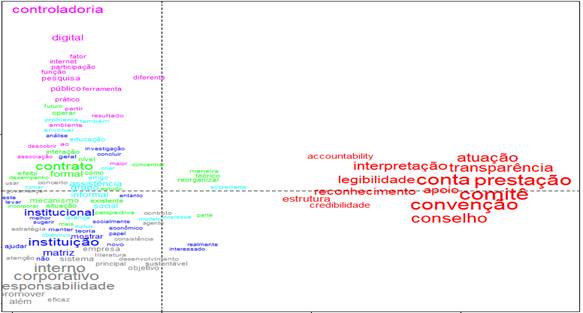
Note. Own elaboration.
In addition to the fact that the red class is distant from the other 4 classes, it is important to note that proximity is essential in the evaluation, because there is a connection between the groups in the classes focusing on the themes of control, participation; institutional, accountability. Thus, it can be deduced from the analysis of the interviews that there is a connection between the aspects of sub-corpus 2 of civil society participation and sub-corpus 1 of control, in the sense that the control and accountability bodies should get even closer to civil society for joint decision-making and, in the opinion of the interviewees, this approach can be promoted and improved by third sector technicians.
The other classes are close, highlighting the lower part of the graph with the terms Institutional; accountability; corporate, which refer to the need for a sufficient management structure to meet the demands for resources for social promotion and projects.
Analysis of interview content
Following the qualitative analysis, a content analysis was carried out, and for this purpose, the unit of data recording used was the theme addressed (Bardin, 1979), based on the categories analyzed and proposed in this study. The weighted analysis of the frequencies in which the interviewees addressed each theme and in each of the cooperation instruments revealed a dispersion of categories.
Table 2
Frequencies of approximation of themes in the data
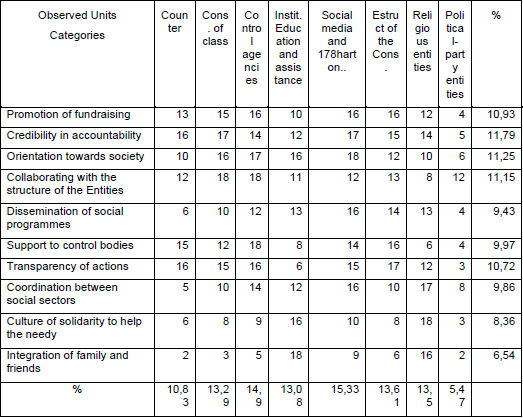
Note. Own elaboration.
As can be seen in the table above, when analyzing the categories in percentage terms, the highest frequency of responses from respondents refers to credibility in accountability, with 11.79%, followed by orientation towards society, with 11.25%, and collaboration with the structure of the Entities with 11.15%.
According to the interview script, the initial question explored the respondents' opinion on the importance of the accounting professional in the process of social management and control, including fundraising for the law. The criterion of incentivizing fundraising was the theme addressed at the beginning of interviewee 1's discourse, when she stressed that it is one of the functions of the accounting class in social programmes.
Figure 6
Analysis by category
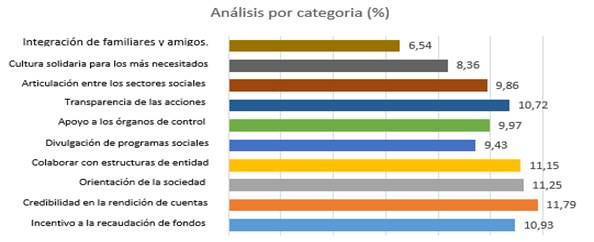
Note. Own elaboration.
According to the interview guide, the initial question explored the respondents' opinion on the importance of the accounting professional in the process of social management and control, including fundraising for the law. The criterion of encouraging fundraising was the theme addressed at the beginning of interviewee 1's discourse, when she stressed that it is one of the functions of the accounting class to participate in and encourage social programmes. This thought was echoed in interviews 7, 8, 9, 10, 11, 12, 15 and 16, reinforcing the understanding of the importance of the accounting professional, both in fundraising actions and in relation to support in the elaboration of accountability on the part of the funds, municipalities and institutions involved.
The response of interview 4 differs somewhat from the previous ones, as it considers an accountant important in this process, but only if he/she acts effectively, and not only if he/she presents him/herself as a professional, and as interviewees 5 and 8 state that the qualification of the professional is essential to be able to help in this process, including in the orientation to the entities. Interviewee 6 stresses that the involvement of the accountant is essential, but with sufficient structure to be able to better guide those interested in participating.
The response of interview 13 highlights the importance of the accountant's participation in transparency, articulation and credibility in the process, and respondents 14, 17 and 18 follow another line of action of the accounting professional in this process, which is education and articulation with society to try to change the culture of participation in this process.
The second question referred to the role of professional class councils in the performance of management and social control processes, especially to the processes of rights funds and social programmes. This question sought to develop social responsibility with the contribution of the third sector (Pinho & Sacramento, 2009).
Respondents 01 and 02 converge in highlighting the importance of the Professional Councils in sensitizing civil society to the opportunity to participate, especially in the aspects of orientation and dissemination of the entities involved, from the point of view of organization, credibility and transparency.
Diverging from the first answers, interviewees 03, 04, 06 and 08 believe that the councils should be more active in their actions with civil society, and that they could have a better performance in the programmes for attracting legal funds.
Interviews 12 and 13 highlight the importance of the councils in supporting the control bodies in their supervisory function, and issues of credibility, ethics and transparency in processes involving social management were also addressed by the interviewees when asked about the Class Councils, according to interviews 15 and 18.
The third issue directly involves legal and social control aspects with the direct participation of external and jurisdictional control bodies. Interviews 1 and 3 highlight the need for these bodies to ensure there is no irregularity or fraud in the process of raising funds for social programs. Interview 4 discusses the actions of the control bodies in a country of continental dimensions, which could jeopardize the results of a statistical analysis if variables with different weights are not placed on geographic and population aspects.
In contrast to the first responses, interviewees 03, 04, 06 and 08 think that councils should be more active in their actions with civil society, being better able to carry out fundraising programmes.
Interviews 12 and 13 highlight the importance of councils in supporting control bodies in the oversight function, and the issues of credibility, ethics and transparency in processes involving social management were also addressed by interviewees when asked about Class Councils, according to interviews 15 and 18.
The third issue directly affects the legal and social control aspects with the direct involvement of external and jurisdictional control bodies. Interviews 1 and 3 highlight the need for these bodies to ensure that there are no irregularities or fraud in the process of collecting funds for social programmes. Interview 4 talks about the performance of control bodies in a country of continental dimensions, which could jeopardize the results of a statistical analysis if variables with different weights are not placed on geographical and population aspects.
Interviews 5, 6, 8, 10 and 13 stress that control bodies should be more effective in monitoring and controlling processes, because credibility is a fundamental element for the good results of social programmes. Interview 14 makes a contribution to the debate, as it moves away from the main function of these bodies, to discuss the contribution that control bodies have the potential to develop in education and culture policies in social actions:
Interview 18 also brings a very important element of debate which is to give support to institutions, a guiding and proactive role, which can contribute more in these processes than punitive supervisory interventions, which in a way inhibit the participation of new actors in the process. According to Iamamoto (2001), it is necessary to promote a permanent political articulation within organized civil society in order to define common proposals and strategies for democracy, aimed at strengthening collective subjects, building alliances with service users in their implementation.
The fourth question referred directly to aspects related to educating citizens to understand the movements of institutions in order to improve accountability and social control processes, especially those related to social rights funds.
The categories of research, incentive to fundraising, orientation to society within the theme of education and social assistance were found in several interviews, suggesting the need for more effective work in schools and universities to disseminate the positive actions of these programmes, according to responses from interviews 1, 5 and 7.
Other determinants of these categories are the dissemination of social programmes and the articulation between social sectors, which goes beyond attracting new resources and dissemination through social programmes, but rather seeks to implement a culture of solidarity in this process. In relation to the role of social assistance institutions, together with education institutions, in this process, respondents consider them essential to contribute to the training of new actors, in a technical way, seeking to contribute to the other councils.
The next question sought to capture the interviewees' perception of the role of the media in the management and social control processes of the rights funds. This question is also related to the communication structure of local councils and municipal entities, which was addressed in the quantitative analysis of this study. The tools and processes of accountability through the media, according to Ebrahim's study (2010), go beyond accounting reports, with the function of communicating the operational and financial performance of social institutions.
According to interviewee 1, participation in social networks has the potential to attract more volunteers to participate in social action events, targeting audiences that have an increasingly effective participation in networks; however, the media actions of these institutions are still far below their potential. Another relevant point raised by the interviewees in this question was the use of the media during the period of social withdrawal, being significant in the dissemination of the programmes.
Some interviewees also point out that there is a risk of ideological, political, economic or other direction distorting the actual results.
The next question referred to the structure of the Councils, which was a variable also explored in the quantitative analysis, and here we explore the perception of the interviewees.
The difficulty of the structures in the municipalities was an element highlighted in practically all the interviews, but converging in the understanding that it is an essential observation unit to improve the performance of the Institutions, as verified in interviews 1, 10 and 15.
After analyzing the talks and conferences carried out previously in this study, it was found that the themes of religion and politics were recurrent in the studies on management and social control, and by studying Brazil, even if only in a sample form, the need to discuss the themes is perceived.
Religious entities were mentioned a lot in the presentations of civil society institutions' fundraising events through the entitlement fund, especially those that could be allocated from parts of the income tax amounts. These highlights of these faith-based organizations sought to raise public awareness of the value of giving, and on the other hand also sought to show transparency in the use of resources for the local community. In this regard, the variable religion was explored with the interviewees with a view to identifying its ability to alter organizational performance.
Interviewees 1, 4 and 12 highlight the importance of the participation of religious entities in the process of social management of resources through social rights funds, and have the power to mobilize civil society in the control of the collection and use of resources.
While recognizing the importance of the participation of religious institutions in the process, interviewees 6, 15 and 17 address the possibility of the risk of fraud, precisely with the argument of helping people in need, but that in reality they would only be fictitious institutions to divert public resources.
Next, the last question of the interview script was explored, which was the possibility of political party interference in these social programmes, with the aim of identifying the interviewees' perception of this variable.
The interviewees agreed on the central idea that there is, to a certain extent, interference by politicians in the process, and that in these cases it should also be controlled by society in order not to distort the aims of the programmes. The interviewees also emphasize that parties should not interfere directly in these donation or allocation processes, but because of local political issues, or because of the possibility of obtaining resources for other social programmes through amendments, more social control is necessary.
Once the content analysis was presented, a graph was drawn up in which credibility in accountability appears as the most representative category among those analyzed, followed by orientation towards society and the category of collaboration with the structure of the entities.
Figure 7
Analysis of the main categories investigated
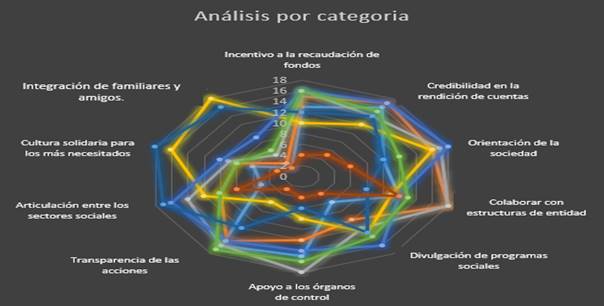
Note. Own elaboration.
The theory of communicative action - TCA, is based on the concept of action, the ability of social subjects to interact within and between groups, rationally pursuing objectives that can be known by the observation of the agent of the action itself, and in this sense, this Habermasian theory prioritizes the understanding of human beings in society and actions of a communicative nature, highlighting the intervention in the dialogue between various subjects (Gutiérrez, 2013). This theory is in line with the categories presented in the graph, with emphasis on the articulation between social sectors, orientation towards society and the dissemination of social programmes.
The category of solidarity culture is also related to the Habermasian theory, because according to Habermas (1984), the individual success of the participants are not the only objectives, but part of a condition of being able to harmonize their action plans with a common basis for all, and in this way, the negotiation of the definition of the situation is an essential part of the interpretative complement that requires the communicative action.
The need for collaboration with the structure of the entities involved in the processes of attracting and allocating incentive funds is an important factor in highlighting the importance of councillor recruitment in this process (Cardoso, 2018).
After quantitative analysis using statistics to present correlations, principal component analysis and non-parametric tests, and qualitative analysis using content analysis and interviews, including the use of correspondence factor analysis resources, similarity graphs and dendrograms, the proposal of this study and the conclusion are presented.
FINAL REMARKS
The theoretical study can contribute to the literature at its current stage, as it allows for the expansion of knowledge on social control, from the point of view of governance with community interaction, which is still scarce and fragmented, and can collaborate with future studies in relation to theoretical consistency for the production of new works on management and social outcomes, society in decision-making, as well as studies on the theoretical tools that can be used to analyze institutions, mechanisms, systems, processes, instruments and procedures for the social control of public spending, as well as research to better understand the process by which individuals come to adhere to a culture of giving with control to avoid deviations, in order to neutralize harmful practices for social development. .
This work also allows future studies to explore the issue of social control through digital communication on a more theoretical basis, as it regulates common agreements between actors on appropriate attitudes and behaviors, which influences actions in accordance with norms and expectations and can therefore function as an incentive to cooperation of each social group, since, through this form of virtual communication, members of the corporation can have greater freedom to communicate anywhere, in any format, in real time, using different media.
From an empirical point of view, this study allows us to broaden the focus of studies on the observation of popular control and monitoring at the municipal level, considering accountability and the criterion of the usefulness of disclosing information to improve accountability practices in social institutions, and can also collaborate with new research in the search for factors that influence the disclosure of information related to accountability, the determinants and its evaluation.
The theoretical model of this study was based on the research objective, from the point of view of what is proposed by the theory of communicative action, the network actor theory and the theory of accountability, observing the presence and manifestation of determinants related to these theories, which constitute the categories of analysis, There is a scarcity of research on the readability of documents that are part of accountability procedures in social organizations, and until now the literature has focused on questions about the determinants of disclosure and transparency, considering the content of accountability as irrelevant, which is why this work may make it possible to broaden the discussion and create new models about the relationships between the determinants.
With the development and dissemination of the results of this research, it is hoped that, from a theoretical point of view, it will be possible to collaborate with new studies that correlate the municipal structure with macro-federal development programmes, inserting communicative action in the studies as a theoretical contribution to citizen participation and improvement in the quality of public management.
In relation to the practical utilities with the results of this research, it stands out the pointing out of the problems in the accountability of the municipal councils that are with restriction to receive resources, to propose solutions of interactions with the civil society, as Universities, Class Councils, Organs of justice and, mainly, Institutions with projects directed to the Councils of Rights. The interpretation of the possibilities of the results also has the potential to stimulate new donations through social programmes.
Finally, the research presents possibilities for new studies with the use of a public database, with free software and indication of research groups in Universities and Professional Councils, which may encourage new researchers to develop projects in this line of research.
REFERENCES
Please refer to articles in Spanish Bibliography.
BIBLIOGRAPHICAL ABSTRACT
Please refer to articles Spanish Biographical abstract.